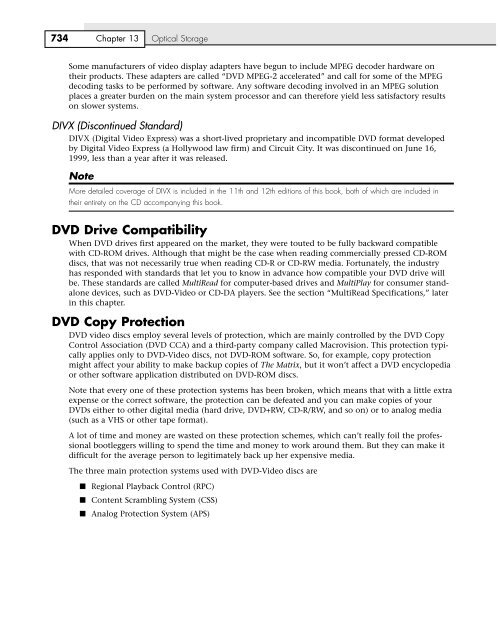You also want an ePaper? Increase the reach of your titles
YUMPU automatically turns print PDFs into web optimized ePapers that Google loves.
734 Chapter <strong>13</strong> Optical Storage<br />
Some manufacturers of video display adapters have begun to include MPEG decoder hardware on<br />
their products. These adapters are called “DVD MPEG-2 accelerated” and call for some of the MPEG<br />
decoding tasks to be performed by software. Any software decoding involved in an MPEG solution<br />
places a greater burden on the main system processor and can therefore yield less satisfactory results<br />
on slower systems.<br />
DIVX (Discontinued Standard)<br />
DIVX (Digital Video Express) was a short-lived proprietary and incompatible DVD format developed<br />
by Digital Video Express (a Hollywood law firm) and Circuit City. It was discontinued on June 16,<br />
1999, less than a year after it was released.<br />
Note<br />
More detailed coverage of DIVX is included in the 11th and 12th editions of this book, both of which are included in<br />
their entirety on the CD accompanying this book.<br />
DVD Drive Compatibility<br />
When DVD drives first appeared on the market, they were touted to be fully backward compatible<br />
with CD-ROM drives. Although that might be the case when reading commercially pressed CD-ROM<br />
discs, that was not necessarily true when reading CD-R or CD-RW media. Fortunately, the industry<br />
has responded with standards that let you to know in advance how compatible your DVD drive will<br />
be. These standards are called MultiRead for computer-based drives and MultiPlay for consumer standalone<br />
devices, such as DVD-Video or CD-DA players. See the section “MultiRead Specifications,” later<br />
in this chapter.<br />
DVD Copy Protection<br />
DVD video discs employ several levels of protection, which are mainly controlled by the DVD Copy<br />
Control Association (DVD CCA) and a third-party company called Macrovision. This protection typically<br />
applies only to DVD-Video discs, not DVD-ROM software. So, for example, copy protection<br />
might affect your ability to make backup copies of The Matrix, but it won’t affect a DVD encyclopedia<br />
or other software application distributed on DVD-ROM discs.<br />
Note that every one of these protection systems has been broken, which means that with a little extra<br />
expense or the correct software, the protection can be defeated and you can make copies of your<br />
DVDs either to other digital media (hard drive, DVD+RW, CD-R/RW, and so on) or to analog media<br />
(such as a VHS or other tape format).<br />
A lot of time and money are wasted on these protection schemes, which can’t really foil the professional<br />
bootleggers willing to spend the time and money to work around them. But they can make it<br />
difficult for the average person to legitimately back up her expensive media.<br />
The three main protection systems used with DVD-Video discs are<br />
■ Regional Playback Control (RPC)<br />
■ Content Scrambling System (CSS)<br />
■ Analog Protection System (APS)
















